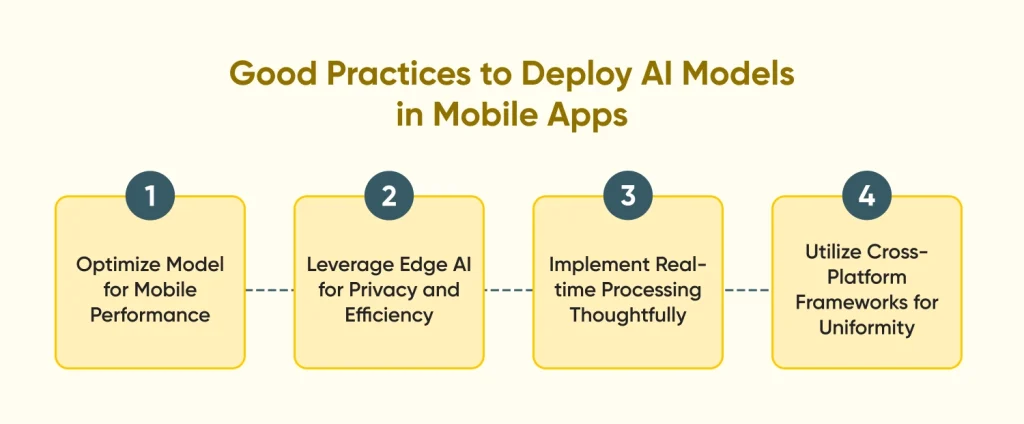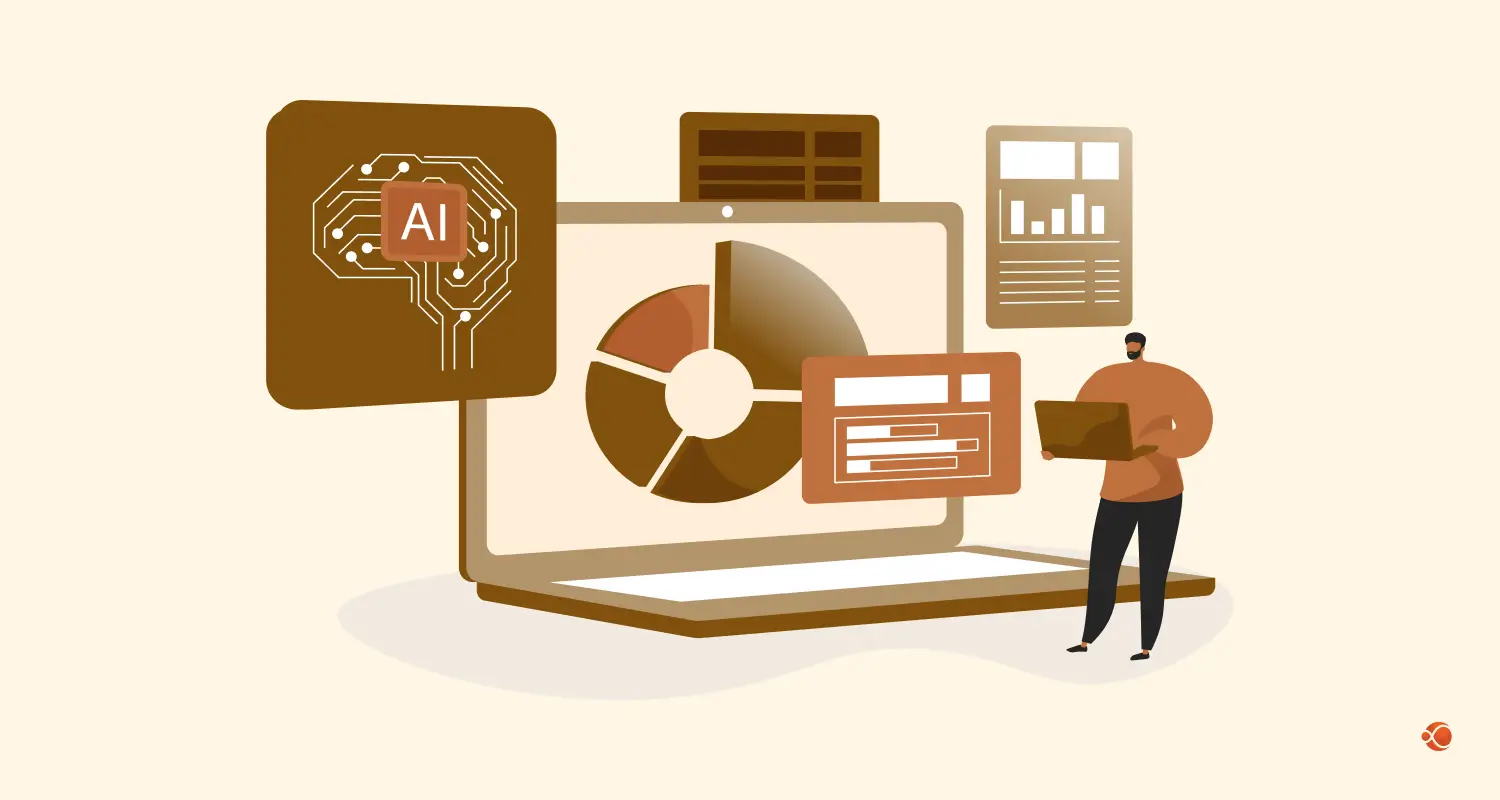Quick Summary: Integrating AI models in mobile app development is an optimal way to optimize mobile app performance, introduce new features, and extend the app’s lifecycle. This blog explores the top AI technologies and real-world examples of how AI can enhance mobile applications, leading to more intuitive user experiences.
The increasing popularity of AI in mobile applications has transformed the way people interact with technology. As of 2025, 72% of companies worldwide report using AI in at least one business function. Most leading AI software development company focus on integrating AI models in mobile app development to drive innovation and enhance user engagement.
Apps powered by AI and Machine Learning can provide extensive data analytics, anticipate user actions, and even offer a template for the user’s experience. However, implementing a trained AI model into a mobile application is a difficult task that requires an efficient model, as well as an understanding of the platforms and the optimization process itself.
This blog covers the technology of implementing trained AI models in mobile apps, the essential technologies, and how to use AI-powered mobile applications effectively.
Implementing AI in Mobile Apps: Essential Technologies and Practical Applications
There are certain particularities that distinguish the integration of AI features into mobile apps from ordinary servers or web applications, which need to be understood before integrating a trained AI model. Mobile apps must have models that are small and energy-efficient for on-device operation. These models enable applications to provide AI-driven features, such as image recognition, NLP, and predictive text, without requiring a constant connection to the server.
If you want to build an interactive mobile app that provides engaging and conversational experiences, developers can create AI agents using GPT technology, thereby enhancing user engagement through natural language interactions. These are key AI concepts for mobile app development.
OS Compliance:
Any model intended for use in mobile operating systems should comply with the appropriate standards defined for the Android or iOS platforms.
Modelling for Mobile Devices:
Mobile device models must be smaller in size and highly efficient, which can be implemented as a standard with TensorFlow Lite technology. Using AI programming languages like Python for model training, developers can optimize AI models for app development to fit the unique constraints and capabilities of mobile platforms.
Data Privacy:
From a security perspective, performing analytical operations on the device enables less data to be sent to third parties, which is a growing concern today. To ensure a smooth integration of AI in mobile applications, businesses should hire dedicated developers who specialize in optimizing and deploying mobile AI models.
Prominent Technologies for the Applications of Artificial Intelligence in Mobile Applications
There are several frameworks that enable developers to run trained AI models in mobile app development, differing in terms of effectiveness and ease of use. Mobile app machine learning enables applications to learn from user interactions, providing smarter, context-driven features that adapt to each individual user. This process is at the heart of AI-integrated mobile app development.
TensorFlow Lite:
TensorFlow Lite is a great artificial intelligence mobile app development tool mainly used for training AI models on Android and iOS operating systems. TensorFlow Lite enables customers to run machine learning models on-device. It uses mobile-optimized, pre-trained models. One of the major benefits of TensorFlow Lite is its ability to work with low latency and support multiple languages, making it highly versatile. Developers can leverage its lightweight and mobile-optimized models to provide on-device AI functionality with minimal latency when implementing TensorFlow Lite in mobile apps.
Core ML:
This one is from Apple as well; Core ML is available on iOS devices, providing a seamless addition of AI features to iOS applications. It exposes a basic API that allows for straightforward on-device ML tasks and is compatible with models created in TensorFlow, PyTorch, and other frameworks.
ONNX (Open Neural Network Exchange):
ONNX is an impressive and robust open-source ecosystem based on the concept of AI model interoperability amongst different AI frameworks, and thus allows developers to create and deploy cross-platform models across Android and iOS devices with little change needed.
Choosing the Right Framework:
While selecting any framework for an application, it is essential to keep in mind the expected operating system of the app, how complex the desired AI model is, and the performance level required from it. The proper resources could facilitate the development stage, augmenting the performance level of the application, and creating it in less time. This is part of the AI powered mobile app development training that many developers go through.

How to Implement a Trained AI Model in Your Mobile Application
Deploying AI models in mobile applications usually occurs through a step-by-step, orchestrated process in general. Here is a more detailed description of the key steps:
Step 1: Describe the Task for Which You Wish to Train an AI Model
Start off with a simple definition of the purpose that your AI model will serve in your app. Image classification, language processing, or predictive analytics. Well, now that you have defined the role, you will be able to then zero down into an appropriate kind and framework for it.
Step 2: Choosing or Training Your AI Model
Once you have defined your purpose, you then have to determine whether you are using a pre-trained model or a custom model:
- Pre-Trained Models: For most applications like image recognition, Pre-trained models are already ready to use. So you save time and resources.
- Custom Models: If your application demands unique functionalities, you have to train a custom model to suit your needs.
This is a key decision in any AI model application.
Step 3: Model Transformation and Optimization for Mobile Implementation.
Mobile devices have limited computing power; therefore, to optimize the AI model, it was originally optimized on a desktop or cloud server.
- Apply model quantization: This refers to reducing the model’s size without compromising accuracy.
- Model pruning: During the pruning of unused parameters during training, performance is enhanced.
- Edge processing technique: Processing data on the device that would eliminate/minimize latency while upgrading security.
Using Edge for mobile application development AI, ensures that data processing happens on the device, reducing dependency on external servers, improving performance, and improving data privacy. With the rise of AI-powered app development, mobile apps can now offer users a variety of features.
Step 4: Model Implementation through Choosing a Suitable Framework
Next, integrate ML model into your app using a proper framework. You can use any of the popular models, such as TensorFlow Lite, Core ML, or ONNX. Hire AI developers to import the model, set up the appropriate input and output layers, and then implement the AI logic within the app’s code. This is the core of how to integrate AI in mobile apps.
Step 5: Test and Optimize for Performance and User Experience
Testing is an important aspect of AI model deployment. It puts the model through various kinds of testing and conditions, helping to track latency and verify the accuracy of predicting outcomes. There should be mobile app performance optimization in place when a problem arises, as real-time processing should not prevent customers from using the product.
What are the Issues in the Integration of AI Models in Mobile Applications
Some challenges arise due to the AI model integration in mobile applications, these include:
Battery Drain and Performance:
This is due to the high demand that AI processing places on the mobile device, which can cause the battery to drain quickly. This can be minimized by achieving an optimized model while ensuring that the balance between on-device and cloud resources is maintained.
Risk of Data Breach:
There are features, such as recommended content, that are AI-based and collect user data. Such methods can be avoided by implementing privacy techniques, such as encrypting data and processing it on the device itself.
Risk of Vulnerability due to Non-Standard Devices:
The mobile app market is divided into different devices with various screen sizes and system processing capabilities. As a mobile app tester, it is crucial to conduct cross-platform UI/UX testing to ensure the app functions as intended across different devices.
Best Practices to Deploy AI Models in Mobile App Development
In order to get the best AI for mobile app development and enhance the functionality of your app, here are some good practices:

Optimize Model for Mobile Performance
We aim to optimize this model for mobile device compatibility and resource efficiency. Skilled mobile app developers use quantization and pruning to help minimize the model’s size and accelerate execution.
Edge AI for Privacy and Efficiency
Edge AI or on-device AI processing has become increasingly popular for mobile applications. With on-device AI processing, developers reduce reliance on external servers. This results in improved performance and privacy for the users, and reduces the latency of the AI features.
Implement Real-Time Processing Thoughtfully
Real-time AI features are beneficial for improving usability. They must be implemented carefully to prevent delays in your mobile app. Refine and optimize the codebase to ensure the app responds quickly to adjustments. This is particularly useful when tasks require immediate feedback, such as voice recognition or camera-based functions.
Utilize Cross-Platform Frameworks for Uniformity
The cross-platform AI frameworks, such as ONNX, can simplify your app’s deployment on both Android and iOS by using the same AI model for both platforms. This way, users get a consistent experience, reduce development time, and use an application that is more aligned with the requirements of its audience.
Best Examples for Implementing AI Models on Mobile Devices
Several popular apps utilize AI models for app development to provide enhanced capabilities:
- Snapchat: Its image recognition and face filters utilize AI algorithms to identify features on users’ faces, automatically creating real-time effects.
- Google Translate: Uses on-device AI to identify and translate words from pictures and does it all without asking for access to your connection.
- TikTok: TikTok utilizes a recommendation algorithm that understands user interactions and preferences to provide individually tailored video feeds.
- Netflix: AI can be used to understand and study users’ preferences based on their viewing histories and content-watching patterns, suggesting new content curated to individuals’ requirements.
- Spotify: Features like Discover Weekly and Daily Mix use AI to learn your music taste and recommend tracks and playlists that match your style. Additionally, with its recent collaboration with Gemini, you can now link your Spotify account to Gemini and use voice or typed requests to search for and play music, podcasts, albums, artists, and more.
- Grammarly: This tool utilizes AI to provide you with real-time suggestions on grammar, spelling, and style, helping you write more clearly and effectively across various apps. It also provides various new AI tools, with their product CODA, an excellent platform for meeting content requirements.
- Lensa AI: It is known for turning photos into creative avatars and applying unique filters. Lensa shows how AI can be used in fun and artistic ways on mobile devices.
- Siri and Google Assistant: These virtual assistants utilize sophisticated AI models for natural language processing, enabling them to respond to voice commands, schedule tasks, and answer questions.
Each of the above examples showcases the power of well-integrated AI, enabling real-time processing and providing smart recommendations that improve the value and experience of the app.
Final Words
By implementing AI Models in mobile app development, companies can build smarter enterprises with AI. Mobile application, enabling more data-driven decisions and seamless automation. Each step in the right framework for optimization on mobile devices takes its toll, but makes AI experiences seamless and powerful. By applying best practices, optimizing for performance, and prioritizing user privacy, smarter, AI-powered mobile applications are sure to meet and exceed expectations.
FAQs on Implementing Trained AI Models
How can I implement a trained AI model in my mobile app?
You may add a trained AI model by selecting an appropriate framework, such as TensorFlow Lite or Core ML, to tailor it for mobile functionality and then embed it into the code of your app to bring in real-time AI features.
What are the best frameworks for integrating AI models into mobile apps?
TensorFlow Lite, Core ML, and PyTorch Mobile top the list of best choices for their specific tools and optimized versions of both Android and iOS apps.
Can I use the same AI model on both Android and iOS platforms?
Yes, it is possible to share an AI model across platforms using frameworks such as TensorFlow Lite and ONNX, which enables cross-platform deployment, thus using almost the same models on Android and iOS with minimal adjustments.
What are the best practices for implementing real-time AI in mobile applications?
Best practices in implementing Real-time AI: This includes optimizing the model for battery efficiency and using edge AI for privacy purposes, achieving the optimal balance between on-device and cloud processing.







